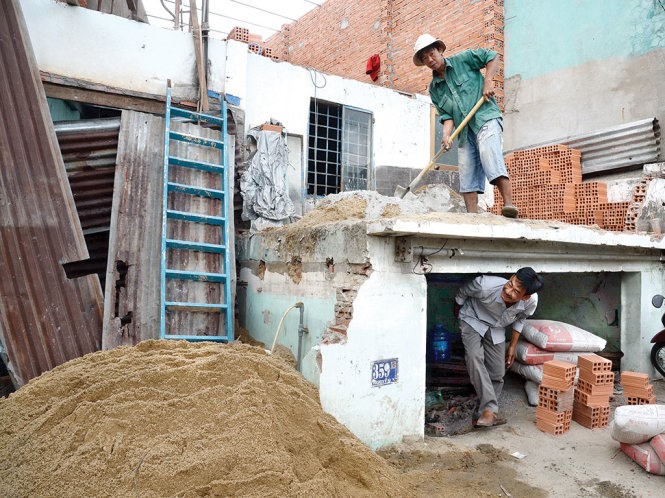 Society
Society

The foundation layers of residential houses and buildings in HCM City are being designed and constructed without proper State office management.
 |
| A house on Nguyễn Xí Street, in HCM City, is rebuilt after the adjacent road was raised. — Photo tuoitre.vn |
HCM CITY — The foundation layers of residential houses and buildings in HCM City are being designed and constructed without proper State office management.
The foundation layer is designed to avoid buildings that are too high or too low compared to the pavement. It is a national benchmarking system used to determine the levels for roads and other constructions.
However, many houses have foundation layers that are not level with the road.
The issue of foundation layers was brought up when city authorities asked home owners to alter the foundations of their properties if they differed from the nationally-approved standard.
Several residents on Nguyễn Xí Street in Bình Thạnh District expressed concern that their homes were being inundated during periods of heavy rain. The foundation of the road was previously raised by local authorities to avoid flooding.
After the work was completed, many of the houses in question were at least 1.5m below the road surface, so rain water flowed into the houses during downpours. Home owners had to raise the foundations of their houses to become equal with the road surface. Some even had to demolish their homes and build them from scratch.
A local woman living on Nguyễn Xí Street said she had raised the foundations of her home by more than 1.3m, leaving the kitchen behind the house at the previous level. When the road surface was subsequently raised, her house was now a metre lower than the road and the kitchen even more so. This situation can cause serious flooding.
On a number of other streets, home owners must measure the height of their floors compared to the existing road level to make the foundation layers, causing discrepancies in the height between neighbouring properties.
Owners of houses with floors much higher than that of the road needed to construct front porches that illegally encroach onto pavements.
Experts warning
State offices have the task of granting construction permits, including the determination of the foundation layers. Authorities grant such permits based on the current foundation layer of the road, however, many of the city’s roads were not built under national standards. This caused a problem, when newly-built houses were not level with the road surface, leading to flooding. The issue was reported on Kinh Dương Vương Street in Bình Tân District, and on Phạm Thế Hiển Street in District 8.
An official from the city’s Department of Urban Management said the determination of the foundation layer for construction licencing was based on the standard ground level from the national elevation markers.
However, he said, it was costly to measure the standard ground level from the national elevation markers.
Most districts were granting permits based on the current foundations of roads and pavements.
Deputy head of Phú Nhuận District’s urban management department, Võ Tấn Nguyên Khôi, said determining the foundation for building residential houses was mainly based on the existing road foundations.
According to Prof Nguyễn Trọng Hòa, former director of the city’s Research and Development Institute, the management of road construction has been inconsistent.
On some roads, investors failed to make accurate measurements before commencing construction, and some investors built roads higher than the surrounding houses.
These failings led to home owners pre-empting the problem, and making the floors of their houses higher than the road surface to start with.
Another reason for the move was poor public drainage systems, which would overflow into houses.
Nguyễn Văn Hiệp, former deputy director of the HCM City Department of Construction, said that the State must establish a permanent standard elevation level.
At each road or in each area, State offices should provide one or two positions for a standard elevation landmark.
The management board of road projects must publish the parameters of the intended foundations so that people can have access to data and determine the correct foundation for their houses before construction.
Văn Hùng Đạt, head of the mapping and measuring office at the city’s Department of Natural Resources and Environment said that in 2016, it had handed over documents relating to 32 standard elevation landmarks to city authorities. — VNS

.jpg)







